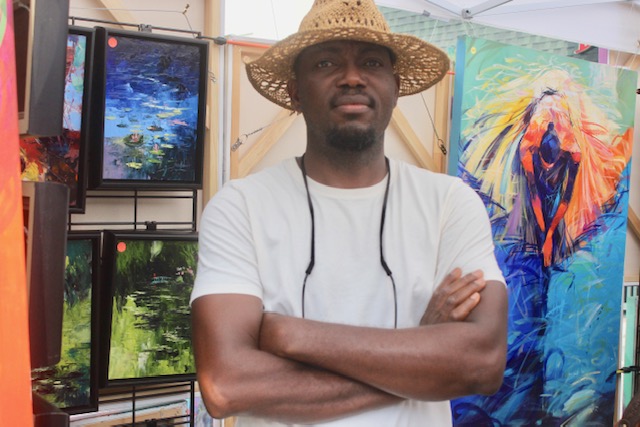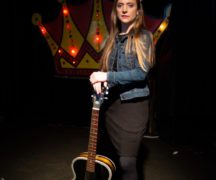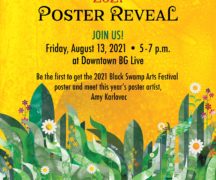By DAVID DUPONT
BG Independent News
Painter Said Oladejo-Lawal has been expanding the number of shows he does close to his home in Columbus. That brought him to the Black Swamp Arts Festival for the first time this weekend. And that earned him best of show honors for the landscapes that touch his heart and the celebrity portraits that draw in buyers.
The exterior of his booth is lined with those pop culture figures. “That’s an aspect of art, pop art,” he said.
Tucked inside the booth are landscapes. “Those are just things I love to do,” Oladejo-Lawal said. “I go to places. I see the landscapes, and I want people to feel what I felt seeing it live, putting it on canvas and letting other people share.”
Though the pop portraits are very colorful and well done, said Brad Scherzer, one of the three judges, the landscapes sealed the deal for him.
Scherzer with Kelsey Scharf, and Andrew Gilliatt served as the jury that decided what who would exhibit in the festival’s juried art show based on digital images. They toured the actual booths on Friday evening to make their choices for awards.
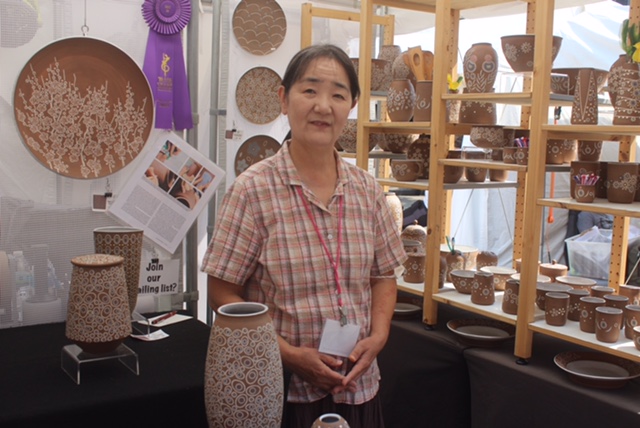
Top 2-D and 3-D awards went to repeat winners from 2019 – ceramicist Sumiko Takada from Upper Arlington, and mixed media artist Nick Ringelstetter, from Spring Green, Wisconsin.
Ringelstetter won best of show honors in 2019 as well as top 2-D in 2018 and Takada was 2-D winner that year.
Other 2021 award winners are:
- Second place, Derrick Riley, a printmaker from Lexington, Kentucky.
- Third place, Joe Dagostino, a photographer from Sagamore Hills.
- Honorable mention: Andrea Pereira de Almeida, painting, Jeneen Hobby, photography, and Robert Bridges, painting.
The Black Swamp Arts Festival continues today (Sept. 12) until 5 p.m. in downtown Bowling Green
Ringelstetter said his response when festival personnel came to give him the ribbon was “come on, guys!”
Some festivals restrict how many times an artist can win. The Black Swamp festival, though, uses a different panel of judges each year, who are not necessarily aware of who won previously.
And Ringelstetter’s work is constantly changing, as he switches up the materials he uses and his process.
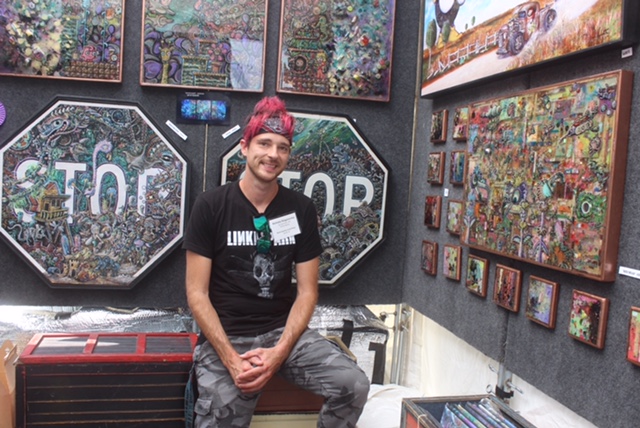
His work, including tricked out stop signs, is built up with layers of resin rocks. It is just flat enough to quality as 2-D. “Imagine you went to a different dimension, a different planet, and cut a chunk out of rock and you bring it back to earth, and they glow in the dark and are UV reactive,” he said.
“The uniqueness of the chaos that you saw with the stop signs drew me in at first but then picking up all these little details is what pulled me over the edge,” Scharf said
“It’s work you just get rewarded for coming closer in and viewing,” Gilliatt said.
The work shown in the booth are smaller versions and prototypes for much larger, and more expensive pieces. He said he is going to be working with an art gallery in Florida on high end art design work. This is his “new dream.”
That may mean doing fewer art fairs. But there are a half dozen shows that he loves and would be sad not to participate in, Ringelstetter said. The Black Swamp Arts Festival is one of them.
“These are my people, my crowds,” he said. He does well in college towns where the patrons are his age. “They’re into the same things I’m into – pop culture, gaming. While I’m here it’s awesome. The feedback is amazing.”
So Ringelstetter expects to come back. “The ultimate goal is to pay bills, get to the next show and keep going and going and going.”
Oladejo-Lawal said he has “scribbled” since he was very young. His painting career began is college in his native Nigeria in 1988.
He brought those skills with him when he and his family moved to the United States in 2009. At that time he enrolled to study graphic design at the Columbus College for Art and Design. Coming to a new country, the degree earned at home was discounted.
His style, which features broad, slashing brushstrokes, and subtle gestures evolved over time.
It came from “a lot of experimentation,” the painter said, “having done so many paintings over time, and trying to convey different expressions with different brush marks. Brush marks make the difference. They tell you a story. So over time I just kind of make the markings mine. It’s still very much evolving.”
Many of his portraits are of the dead personages, and he includes quotations from the subjects. This allows them to speak from the grave. They are the words these people lived by, he said, and he includes them so viewers can look at them and think. “I notice people don’t do so much thinking.”
Takada’s ceramics are also rooted abroad. She started studying art in middle school in Japan, but the inspiration came later when she visited Spain. There she saw designs and materials, she wanted to use. But that wasn’t possible back in Japan. It was only when Takada moved to the United States that she realized this vision.
Gilliatt described the work as: “Darker body stoneware with intricate, white minimalist designs. It’s very well done and original work.”
Takada was pleased with the award, which she noted is a large prize for this size show, $1,000 for best 3-D and 2-D. Best of show award winner receives $1,500, second place, $800, third place $500, and honorable mention, $200. Winners also gain admission to the next year’s show without having go through the jury process.
That’s motivation for returning, Takada said.
She said sales at Black Swamp were good as of Saturday afternoon, and seemed to be picking up.
The rest of the season has been “a rollercoaster,” she said with her husband, Kaname Takada, also a ceramicist and a professor at the Columbus College of Art and Design, translating.
This year “the good ones were really good, and the bad ones were really bad.”

